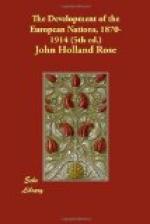Even so his position was most serious. In front of him, at no great distance, was a far superior force flushed with fanaticism and the hope of easy triumph; the River Helmand offered little, if any, protection, for at that season it was everywhere fordable; behind him stretched twenty-five miles of burning desert. By a speedy retreat across this arid zone to Khushk-i-Nakhud, Burrows averted the disaster then imminent, but his anxiety to carry out the telegraphic orders of the Commander-in-chief, and to prevent Ayub’s force from reaching Ghaznee, led him into an enterprise which proved to be far beyond his strength.
Hearing that 2000 of the enemy’s horsemen and a large number of ghazis had hurried forward in advance of the main body to Maiwand, he determined to attack them there. At 6.30 A.M. on July 27 he struck camp and moved forwards with his little force of 2599 fighting men. Daring has wrought wonders in Indian warfare, but rarely has any British commander undertaken so dangerous a task as that to which Burrows set his hand on that morning.
During his march he heard news from a spy that the Afghan main body was about to join their vanguard; but, either because he distrusted the news, or hoped even at the last to “pluck the flower, safety, out of the nettle, danger,” he pushed on and sought to cut through the line of the enemy’s advance as it made for Maiwand. About 10 A.M. his column passed the village of Khig and, crossing a dried watercourse, entered a parched plain whereon the fringe of the enemy’s force could dimly be seen through the thick and sultry air. Believing that he had to deal with no large body of men, Burrows pushed on, and two of Lieutenant Maclaine’s guns began to shell their scattered groups. Like wasps roused to fury, the ghazis rushed together as if for a charge, and lines of Afghan regulars came into view. The deceitful haze yielded up its secret. Burrows’ brigade stood face to face with 15,000 Afghans. Moreover some influence, baleful to England, kept back those Asiatics from their usually heedless rush. Their guns came up and opened fire on Burrows’ line. Even the white quivering groups of their ghazis forebore to charge with their whetted knives, but clung to a gully which afforded good cover 500 yards away from the British front and right flank; there the Afghan regulars galled the exposed khaki line, while their cannon, now numbering thirty pieces, kept up a fire to which Maclaine’s twelve guns could give no adequate reply.
[Illustration: Battle of Maiwand]
It has been stated by military critics that Burrows erred in letting the fight at the outset become an affair of artillery, in which he was plainly the weaker. Some of his guns were put out of action; and in that open plain there was no cover for the fighting line, the reserves, or the supporting horse. All of them sustained heavy losses from the unusually accurate aim of the Afghan gunners. But the enemy had also




